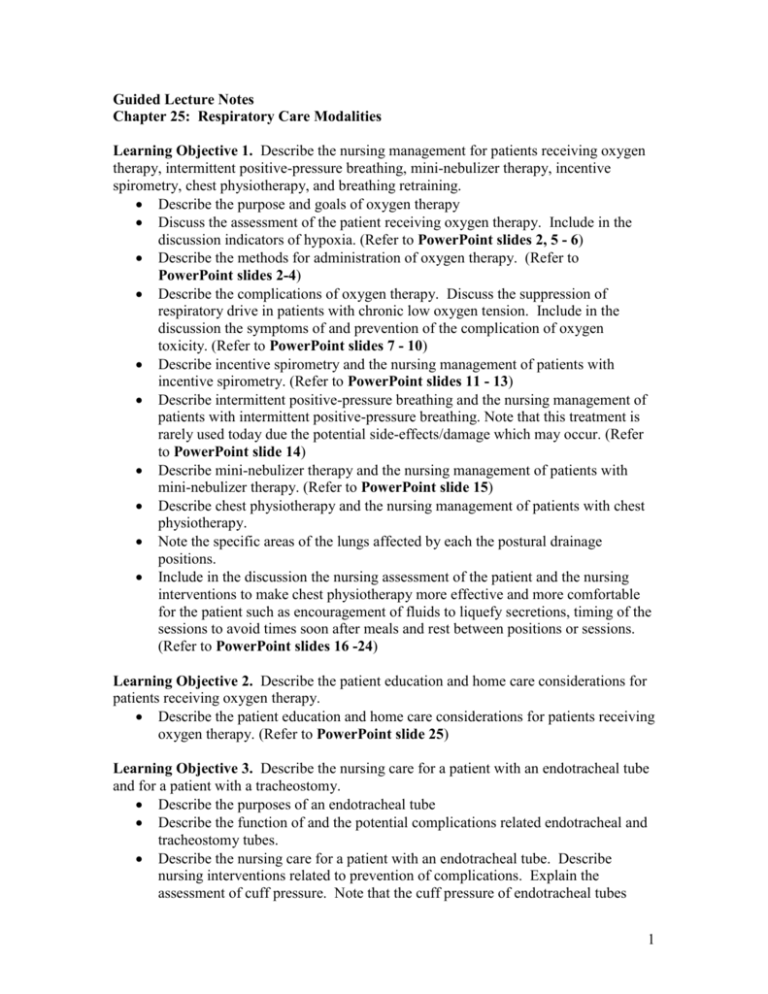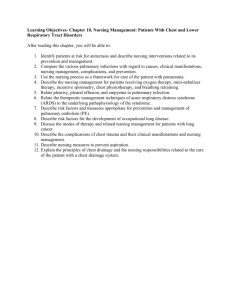Smeltzer Textbook of Medical Surgical Nursing
advertisement

Guided Lecture Notes Chapter 25: Respiratory Care Modalities Learning Objective 1. Describe the nursing management for patients receiving oxygen therapy, intermittent positive-pressure breathing, mini-nebulizer therapy, incentive spirometry, chest physiotherapy, and breathing retraining. Describe the purpose and goals of oxygen therapy Discuss the assessment of the patient receiving oxygen therapy. Include in the discussion indicators of hypoxia. (Refer to PowerPoint slides 2, 5 - 6) Describe the methods for administration of oxygen therapy. (Refer to PowerPoint slides 2-4) Describe the complications of oxygen therapy. Discuss the suppression of respiratory drive in patients with chronic low oxygen tension. Include in the discussion the symptoms of and prevention of the complication of oxygen toxicity. (Refer to PowerPoint slides 7 - 10) Describe incentive spirometry and the nursing management of patients with incentive spirometry. (Refer to PowerPoint slides 11 - 13) Describe intermittent positive-pressure breathing and the nursing management of patients with intermittent positive-pressure breathing. Note that this treatment is rarely used today due the potential side-effects/damage which may occur. (Refer to PowerPoint slide 14) Describe mini-nebulizer therapy and the nursing management of patients with mini-nebulizer therapy. (Refer to PowerPoint slide 15) Describe chest physiotherapy and the nursing management of patients with chest physiotherapy. Note the specific areas of the lungs affected by each the postural drainage positions. Include in the discussion the nursing assessment of the patient and the nursing interventions to make chest physiotherapy more effective and more comfortable for the patient such as encouragement of fluids to liquefy secretions, timing of the sessions to avoid times soon after meals and rest between positions or sessions. (Refer to PowerPoint slides 16 -24) Learning Objective 2. Describe the patient education and home care considerations for patients receiving oxygen therapy. Describe the patient education and home care considerations for patients receiving oxygen therapy. (Refer to PowerPoint slide 25) Learning Objective 3. Describe the nursing care for a patient with an endotracheal tube and for a patient with a tracheostomy. Describe the purposes of an endotracheal tube Describe the function of and the potential complications related endotracheal and tracheostomy tubes. Describe the nursing care for a patient with an endotracheal tube. Describe nursing interventions related to prevention of complications. Explain the assessment of cuff pressure. Note that the cuff pressure of endotracheal tubes 1 should be checked every 8-12 hours and a pressure between 15 and 20 mm Hg. is suggested (Refer to PowerPoint slides 26 -27) Note that cuff pressure on tracheostomy tubes is maintained between 15-25 mm Hg. Tracheostomy cuff pressures exceeding 25 mm Hg may cause injury to tissue and a cuff pressure of 15 mm Hg. is suggested to prevent aspiration. Not all persons with a tracheostomy may require the cuff to be inflated. Describe the methods for assessing trach cuff pressure which include a manometer, the minimal leak volume, and the minimal occlusive volume technique. Discuss potential risk for injury and potential airway compromise related to inadvertent removal of the endotracheal tube and methods to prevent patient removal of the tube. Discuss the judicious use of restraints and the role of patient and family education. Discuss the purpose and potential complications of trachestomies. Discuss the nursing care of the patient with a tracheostomy. (Refer to PowerPoint slides 28 - 29) Discuss the nursing diagnoses listed. Give examples of specific interventions related to the care of patients with endotracheal intubation or tracheostomies which address these diagnoses. (Refer to PowerPoint slide 30) Learning Objective 4. Demonstrate the procedure of tracheal suctioning. Discuss suctioning of endotracheal and tracheostomy tubes. Review the specific skill of suctioning of the tracheostomy. Demonstrate this skill as necessary. Learning Objective 5. Use the nursing process as a framework for care patients who are mechanically ventilated. • Describe the use of the nursing process to care for patients who are mechanically ventilated. • Describe the purpose of mechanical ventilation. • List and explain the indications for mechanical ventilation. Give examples. • Describe the types of positive pressure and negative pressure ventilators. (Refer to PowerPoint slides 31 -32) Negative-Pressure Ventilators Iron Lung (Drinker Respirator Tank) Body Wrap (Pneumo-Wrap) and Chest Cuirass (Tortoise Shell) Positive-Pressure Ventilators Pressure-Cycled Ventilators Time-Cycled Ventilators Volume-Cycled Ventilators Noninvasive Positive-Pressure Ventilation • Briefly discuss the use of and indications for noninvasive positive pressure ventilation and Explain CPAP and biPAP. (Refer to PowerPoint slide 33) 2 • Explain ventilator modes. Note the particular nursing assessments and nursing care interventions which are most important for the different modes of ventilation. (Refer to PowerPoint slide 34) • Describe the assessment of the patient who is mechanically ventilated. • Describe the assessment of the mechanical ventilator. Explain how to “trouble shoot” the ventilator. (Refer to PowerPoint slide 35) • Explain the patient should always be assessed first and what to do if the ventilator machine malfunctions. • Discuss nursing diagnoses common to patient who are mechanically ventilated. (Refer to PowerPoint slide 36) • List the collaborative problems which may occur with patient who are mechanically ventilated. (Refer to PowerPoint slide 37) • Define and explain barotrauma. • Explain the physiologic basis for cardiovascular complications related to mechanical positive pressure ventilation. • Discuss the goals of care for patients who are mechanically ventilated. (Refer to PowerPoint slide 38) • Describe specific nursing interventions related the care of patient who are mechanically ventilated. Explain the rationales for the interventions. Use examples. (Refer to PowerPoint slides 39 - 42) • Enhancing Gas Exchange • Promoting Effective Airway Clearance • Preventing Trauma and Infection • Promoting Optimal Level of Mobility • Promoting Optimal Communication • Promoting Coping Ability • Monitoring and Managing Potential Complications Alterations in Cardiac Function Barotrauma and Pneumothorax Pulmonary Infection Learning Objective 6. Describe the process of weaning the patient from mechanical ventilation. Explain and describe the process of weaning. (Refer to PowerPoint slide 43) • Criteria for Weaning • Patient Preparation • Methods of Weaning • Weaning From the Tube • Weaning From Oxygen • Nutrition Learning Objective 7. Describe the significance of preoperative nursing assessment and patient teaching for the patient who is to have thoracic surgery. 3 • Describe the significance of preoperative nursing assessment and patient teaching for the patient who is to have thoracic surgery including postoperative nursing management. (Refer to PowerPoint slide 44) o Preoperative Nursing Management Improving Airway Clearance Teaching the Patient Relieving Anxiety o Postoperative Nursing Management o Monitoring Respiratory and Cardiovascular Status o Improving Gas Exchange and Breathing o Improving Airway Clearance o Relieving Pain and Discomfort o Promoting Mobility and Shoulder Exercises o Maintaining Fluid Volume and Nutrition o Monitoring and Managing Potential Complications Learning Objective 8. Explain the principles of chest drainage and the nursing responsibilities related to care of the patient with a chest drainage system. Explain the purpose of chest drainage. (Refer to PowerPoint slide 45) • List the types of chest drainage systems. • Water Seal Systems • Dry Suction Water Seal Systems • Dry Suction Systems with a One-Way Valve • Describe a typical chest drainage system and its function. (Refer to PowerPoint slide 46) • Students have much difficulty understanding the relationship of the intrathoracic space with the various chambers of the chest drainage system. Explain the drainage chambers as these relate to the pleural space and to the maintenance or reestablishment of negative intrathoracic pressure. • Explain the application and control of suction to the chest drainage system. Students often have difficultly understanding that the suction pressure is related to the setting on the control device or the height of fluid in the suction control chamber and not to the amount of external suction applied. State specifically and reinforce this information. • Discuss the management of a patient with chest drainage. Describe specific nursing assessments and interventions. Explain, in detail, how to assess that a chest tube system is functioning. Describe the bubbling which occurs in a typical water seal system when it is functioning correctly and when it has an air leak. • Discuss the prevention of cardiopulmonary complications in patients with chest drainage. • Explain the use and function of the Heimlich valve. (Refer to PowerPoint slide 47) Learning Objective 9. Describe the patient education and home care considerations for patients who have had thoracic surgery. 4 Describe the patient education and home care considerations for patients who have had thoracic surgery. Give specific examples. (Refer to PowerPoint slides 48 -49) 5




